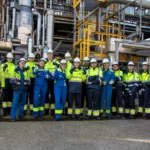An enabling framework for an efficient and effective transformation
Cefic supports the Green Deal and Europe’s ambition to become climate-neutral by 2050. The Green Deal recognises that energy-intensive industries, such as chemicals, are essential to Europe’s transition, providing solutions across multiple value chains. Achieving climate neutrality by 2050 entails a significant transformation in the chemical sector within just one or two investment cycles. To make this possible, Cefic calls for an enabling framework to support the industry’s efficient and effective transformation.
EU 2040 climate target
The European Commission issued its recommendation for an ambitious 2040 climate target for the EU: a 90% reduction in net GHG emissions from 1990 levels.
To meet the EU climate targets, immediate investments are crucial, especially as the industry faces a severe economic downturn and shifting investment opportunities. Europe needs to enhance its economic attractiveness with a clear and competitive policy framework to deliver a successful transformation.
Cefic calls for the following key actions:
- Creating a market for net zero, low-carbon footprint and circular products.
- Deploying essential infrastructure for renewable and low-carbon energy.
- Allowing all emission reduction solutions.
- Supporting the scale-up of and de-risking new technologies with improved funding access.
- Stopping carbon and investment leakage through a robust anti-leakage framework.
The chemical industry works with and supports policy makers to identify the means of a successful transition to a climate-neutral future.
Download the Cefic statement on the 2040 climate target
Download Cefic response to the commission public consultation on an EU climate target for 2040
Industrial carbon management
In light of the EU’s 2040 climate target, Cefic emphasises the need for a robust industrial carbon management strategy, given the industry’s reliance on carbon. This strategy is crucial for aligning Europe’s climate and circularity goals and addressing current bottlenecks.
Technological advancements alone are insufficient for achieving climate neutrality; a well-structured approach supported by a clear legislation and accounting framework is necessary. A robust carbon accounting framework must avoid double counting and clarify emissions accounting and allowances.
To support effective carbon management and maintain industrial competitiveness, key measures include:
- Advancing carbon capture technologies: Supporting Carbon Capture and Utilisation (CCU) and Carbon Capture and Storage (CCS) with appropriate incentives and infrastructure is essential.
- Integrating carbon removals into policy: Including innovative carbon removals in EU policies will help manage emissions more effectively and cost-efficiently.
- Boosting funding for innovation: Enhanced support for R&D and operational costs is vital to maintaining competitiveness and driving progress.
Download the Cefic response to commission consultation on industrial carbon management
Download the Cefic research paper on chemical industry access to CCS
Download the Cefic Position on Carbon Capture and Storage (CCS) can contribute to meeting Paris Agreement GHG Emission ambition
Download the Cefic Position on the chemical valorisation of CO2
Sustainable carbon cycles
Cefic supports the European Commission’s initiative on restoring sustainable carbon cycles, as a crucial step towards effective carbon management. While the chemical industry strives to reduce its carbon footprint through enhanced resource efficiency, circularity, and low-carbon energy, carbon remains central to many chemical processes and products. Thus, access to alternative carbon sources, including waste, biomass and captured CO2 is essential.
Cefic also views the European Commission’s initiative to establish a regulatory framework for carbon removal certification as a step toward acknowledging the role of technological solutions in achieving the EU’s climate neutrality goal. The role of carbon removals is expected to become significant by 2050 to compensate hard-to-abate emissions.
Cefic emphasises that achieving sustainable carbon cycles will require a balanced approach, prioritising emission reduction while fostering innovation in low-carbon technologies.
Download the Cefic position paper on restoring sustainable carbon cycles
EU Carbon Market, ETS and CBAM
The European chemical sector, as an energy-intensive industry, faces the challenge of matching competitiveness with the need to reduce emissions. The EU Emissions Trading System (ETS) provides a market-based solution to drive emission reductions cost-effectively, rewarding innovation while maintaining fair competition within the global market.
Cefic supports the ETS as a key instrument for reducing emissions efficiently across Europe. To remain competitive on a global scale, the chemical industry also requires robust carbon leakage provisions. These include allocating free emission allowances to the best-performing installations and compensating for carbon-related electricity costs. Without these measures, the rising costs of carbon could risk reducing EU investments, undermining the long-term sustainability of the sector.
The CBAM seeks to level the playing field by imposing an equivalent carbon cost on imports from countries with less stringent climate policies. For its successful implementation, Cefic emphasises the importance of:
- Indirect carbon costs: These should be included to address higher cost bases for EU industries.
- Full value chain coverage: The mechanism should cover entire value chains to prevent circumvention.
- Export competitiveness: Solutions are needed to support the EU’s export competitiveness, as the current CBAM design is geared only towards imports.
- Feasibility: Adequate rules and procedures must be established for effective CBAM implementation, including defining embedded carbon and ensuring proper verification and customs procedures.
Download the Cefic consultation response on ETS State Aid Guidelines review
Download the Cefic position on Carbon Border Adjustment Mechanism (CBAM)













